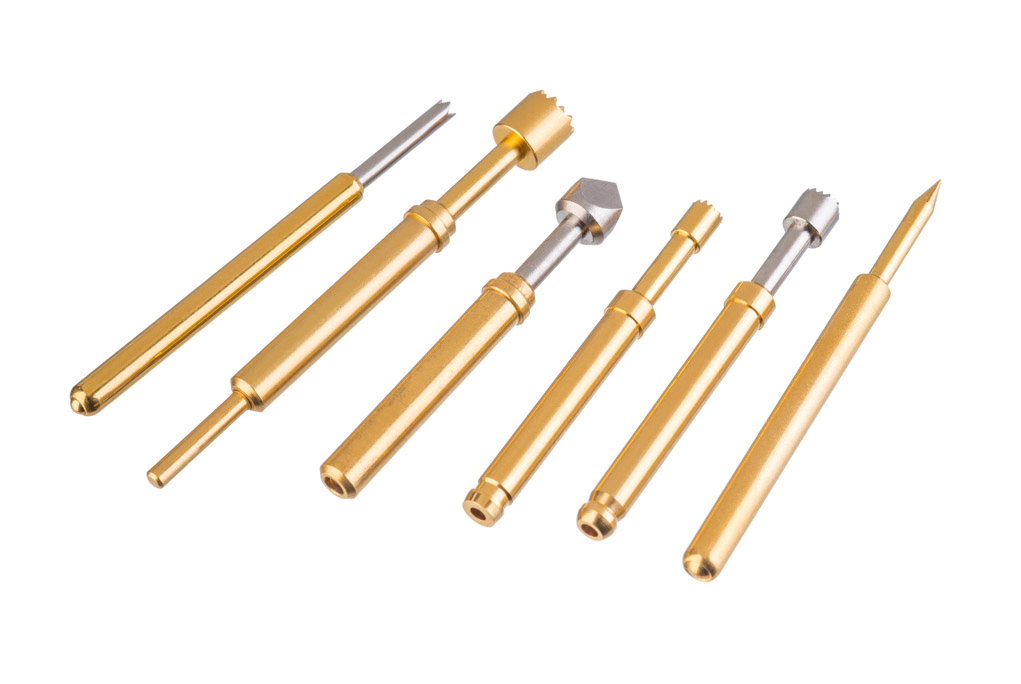What is a Spring Contact Probe?

Spring Contact Probes (additionally alluded to as Pogo Pins, Test Pins, Spring Pins, and so on) are utilized to connect to different test points on different electronic parts for continuity tests. Spring contact probes are normally comprised of a cylindrical barrel, a spring, and a plunger.
The customary use for contact probes is to connect with printed circuit boards (PCB) or electrical parts to test functionally and measure the value of the parts.
They are utilized for the Wafer test (WL-CSP, Flip Chip) in the front-end process and the semiconductor package test (BGA, CSP, QFN, Child) in the back-end process. Additionally, they can be likewise utilized for FPD lighting inspection tests, printed circuit board continuity tests, battery charge-release tests, and other different part tests.
The creation of electronic circuits on a mass scale expects far-reaching automation. This applies to the production of PCBs, the arrangement of parts, as well as their welding. Notwithstanding, even the most effective creation cycle can be dialed back at the last quality control stage. That is the reason advanced ICT (In-Circuit Tests) solutions, which confirm a circuit and its boundaries through a robotized series of estimations, are being utilized increasingly more on creation lines. This sort of investigation has been performed for a long time – yet the rising scaling down of hardware requires perpetually exact probing of PCBs and wire harnesses. In the time of correspondence circuits working at huge frequencies, the actual estimations should likewise be more precise, while the general utilization of digital circuits has irreversibly changed ICT systems. Today we frequently experience the contraction FCT (functional testing), which alludes to the definite check of a circuit’s activity currently in the last creation stage, by driving it up and recreating its activity in the completed gadget. Electronic circuit testers are made of a lot of parts – holders, controllers, measuring circuits, and sensors. They are programmable and configurable gadgets. They additionally contain one fundamental working component: test probes. These are precision, spring-loaded probes intended to make great, yet brief, contact with circuit components – fundamentally the leads of passive components and ICs and regions on a PCB. Other than making estimations and checking the progression of ways, they are additionally utilized for different purposes. They can enter connectors and permit contact connection testing without taking advantage of the socket and plug housing They are additionally utilized in digital electronics where they are applied, in addition to other things, to program microcontrollers utilizing the ISP (In-System Programming) procedure and to complete tests by speaking with the frameworks introduced in the circuit (for example through a serial port or the CAN bus in the automotive sector). Particular contact probes are utilized in the assembling of batteries, or rather cells and packs, which should be charged to the ideal level for stockpiling and transport before being put away. A significant area of use for contact probes is in electronic administrations, where automated circuit testing can accelerate the course of fault detection and rectification.

Here Are Some Kinds Of Test Probes
SWITCHING TEST PROBES
Switching test probes are accessible in different designs, from basic plug-in types to threaded sorts to easy replacement systems. Contingent upon the series utilized focuses from 4.0 mm to 1.27 mm can be accomplished.
For each situation, the electrical connection is through an association on the pin of the switching test probe and one on the receptacle. If maintenance or replacement assembly is required, consistently discharge the connection on the pin and rewire. It is smarter to utilize the sorts which have a simple replacement framework.
Wiring happens totally once just on the receptacle, which has an insulated socket in its end, and this guarantees electrical partition. The switching test probe is fitted with a connector pin which, when it is screwed into the receptacle, is directed straightforwardly into this attachment. Assuming maintenance is required, it is simply important to supplant the contact – no rewiring is required.
Series 3014/2G, 3024/2G, and 3024, which have a general length of just 24.5 mm, are particularly compact. As another option, both series are accessible with the simple replacement system. Series 3015/G, with its ball-shaped design and a working travel of just 0.8 mm, is particularly reasonable for applications in which horizontal contact is essential.
Switching probes (SKS) are reasonable for the majority of different applications: besides the fact that they can be utilized for component detection tests and switches for closed/open checks, yet additionally as a signal trigger for process control. Moreover, in mixed with other test probes (e.g., push-back probes), position assurance of contact terminals in plug housing is conceivable. That implies that the electric circuit is shut when the plunger is initiated, permitting the plunger to be driven further past the switching point. The rated current applied must be sent in the closed state.
STEP PROBES
A “Step” or “Cap” test demonstrates the idea of utilizing a “step” to control the distance of the test tip section into a wire bridle connector lodging, consequently permitting electrical contact to be made to a terminal without in reality entering the terminal. The basic region of the connector terminal stays virgin to guarantee appropriate conductivity and intermetallic connections once the saddle is gathered into its end use.
Contingent upon the client’s inclination, Step Probes can be either replaceable or non-replaceable. All replaceable Step Probes include a Pylon Bend, to keep the walkout of the tests from the repository. Nonreplaceable tests have a press ring, which holds the test set up and holds it back from leaving the mounting section. However, utilized only in the wire saddle testing industry they can likewise be utilized in ICT/FCT testing. ECT offers different pitches and step profundities to oblige most tackle test prerequisites.
IN-CIRCUIT TEST PROBES
The in-circuit test (ICT) includes the estimation of all singular parts of a gathering. Inadequate parts are identified and can be supplanted if essential. The capability test (FCT) checks a gathering capabilities 100% as planned. The testing environment recreates the planned field of utilization and the electrical way of behaving of the get together is tried.
A large number of various test tests are accessible for the ideal satisfaction of the reaching task. These vary in establishment level, lattice size (conceivable distance between tests), tip style, and association type. The electrical association is frequently made by means of a weld cup, a wire-wrap post, as well as regardless of link.
FLYING PROBES
The Flying Probe analyzers are planned as a thread variant and are reasonable for use in Acculogic (Scorpion) and Digital test probe system.
An extraordinary locking framework and very high accuracy of the single part.
HIGH CURRENT TEST PROBES
High-current test probes are utilized when higher flows are involved. Because of their minimal plan, these series are accessible for focuses of 2.54 mm to 5.0 mm with countless different tip styles. On the other hand, all series are accessible in a strung kind which guarantees a great fit in the repository.
In view of PTR’s standard sizes, the high-current sorts are fitted with a parted plunger. During reaching, the two pieces of the plunger are squeezed against one another and, thus, against the barrel wall. The subsequently expanded contact with the barrel wall and the in general more prominent contact surface imply that the test can be exposed to higher flows, contingent upon the series, of 16.0 A to 400.0 A (HSK 5455).
High current test tests (HSS) are utilized in numerous ventures and for applications with high flows, for example for testing, for capability tests, for signal transmission, for power supply, underway and as an inherent contact component. One more field of utilization is exact estimations, for which test tests with exceptionally low inward obstruction are required, supposed low-ohm test tests.
Screw-in tests are suggested for applications with vibrations, above establishment, and where there is a risk of probe moving out of the repository (snapping impact).
TWOFOLD ENDED/WIRELESS TEST SPRING PROBES
Twofold finished probes include both a top-side and base-side consistent plunger.
Twofold finished repositories are accessible with a super durable base side plunger and a replaceable test on the top side.
They are likewise accessible with both a top and base side replaceable test.
Now that you have slight information about test probes and their types, we would appreciate it if you visit our site and have a look at the products that we offer. Want to get a quote on your products? Please visit our page and eradicate your confusion.

